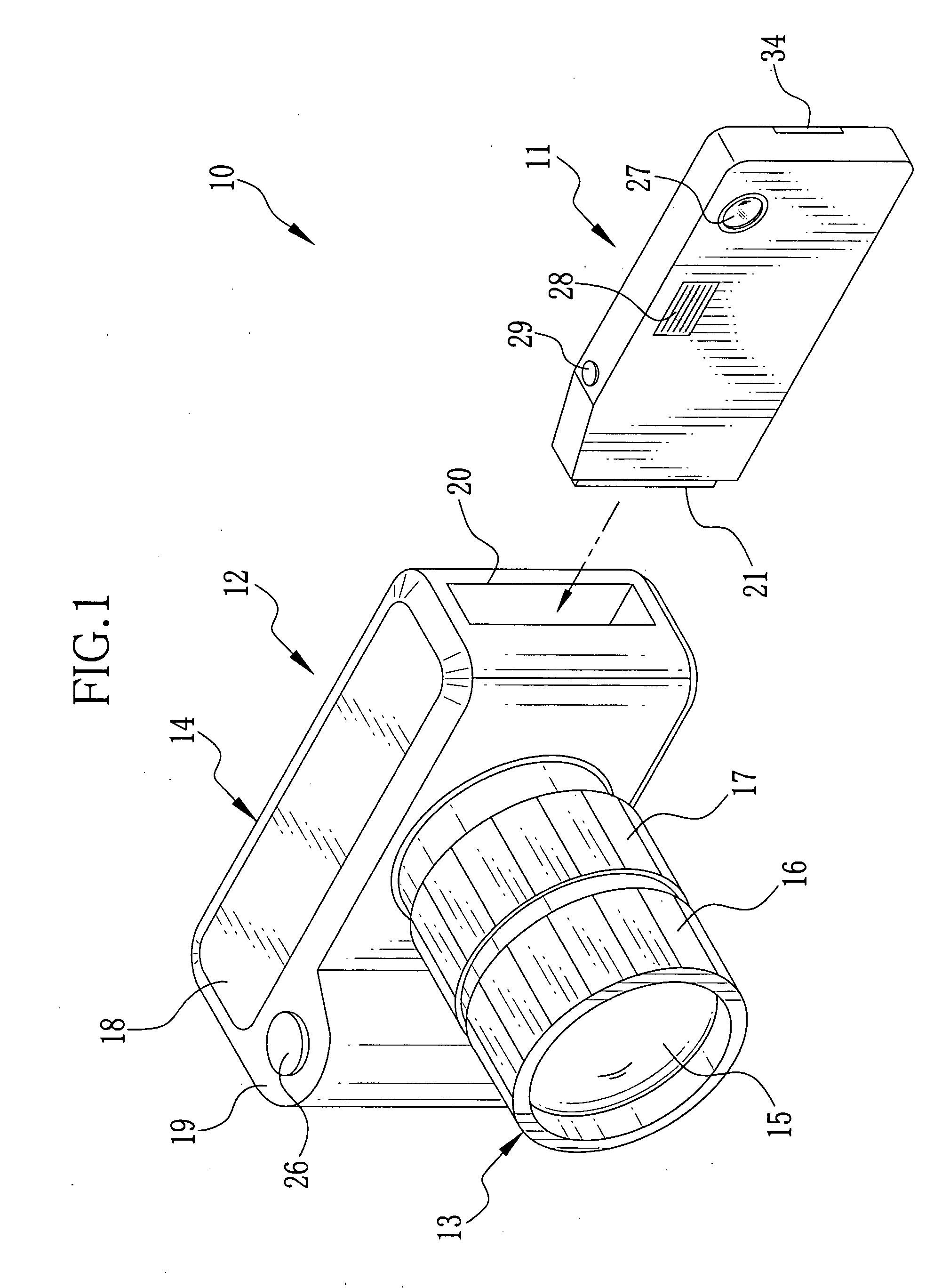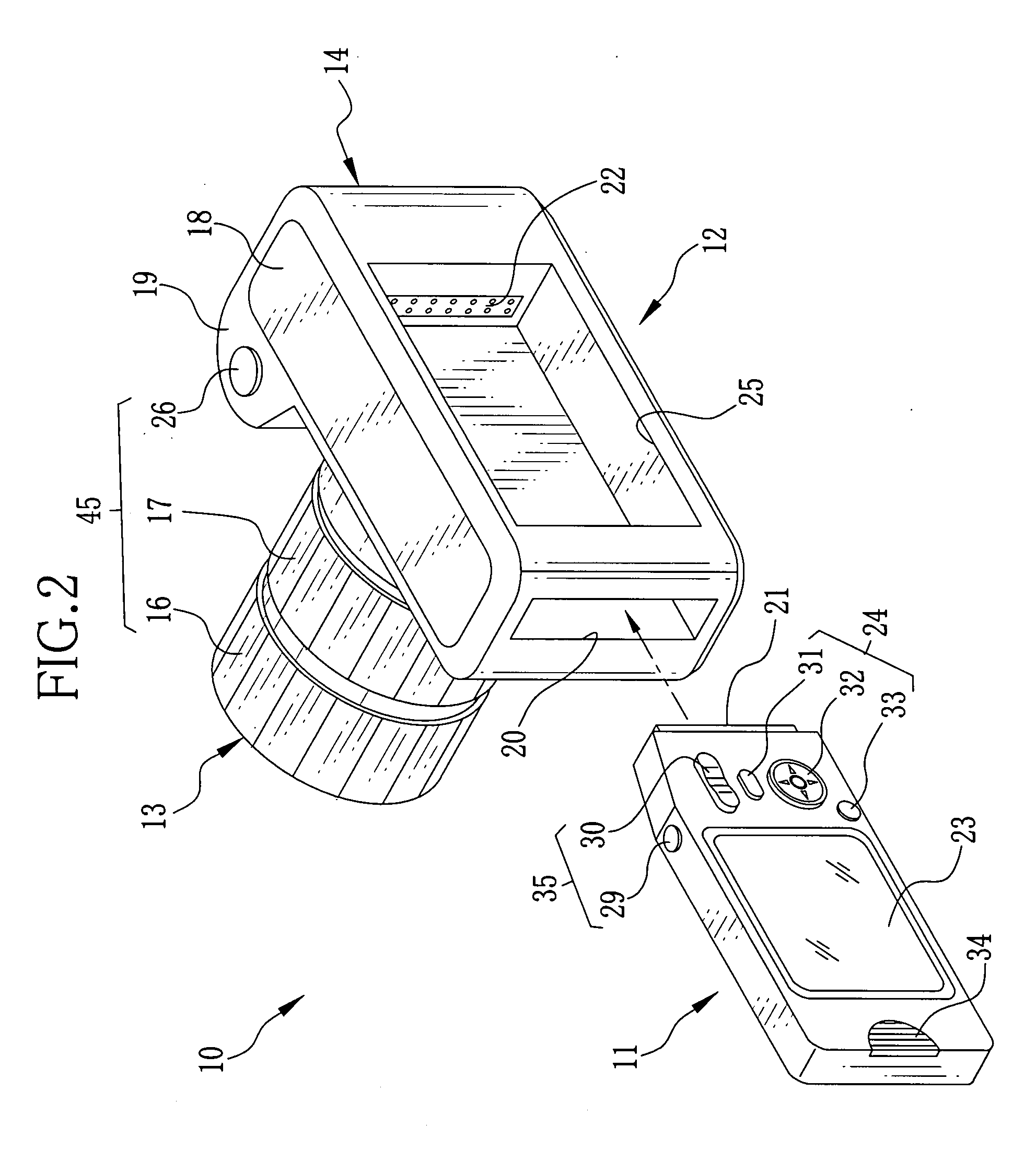Camera and lens unit
a technology which is applied in the field of lens unit and camera body, can solve the problems of confined use of camera body without lens unit, and the grip is not always optimal for any kind of interchangeable lens unit, and achieve the effect of optimal gripping
- Summary
- Abstract
- Description
- Claims
- Application Information
AI Technical Summary
Benefits of technology
Problems solved by technology
Method used
Image
Examples
first embodiment
[0047] In FIGS. 1 and 2, a camera 10 consists of a first unit 12 (lens unit) and a second unit 11 (camera body) detachably attachable to the first unit 12. The first unit 12 consists of a cylindrical lens barrel 13 having an optical system 40 and an imaging device 44 mounted therein, see FIG. 3, and a base body 14 affixed to the lens barrel 13.
[0048] The lens system is superior in optical performance (for example, aberration, resolution, and open f number). The imaging device 44 has many pixels, so use of the first unit 12 allows the user to capture high-quality images.
[0049] A taking lens 15 of the optical system 40 is exposed on a front face of the lens barrel 13, and a rear end of the lens barrel 13 is connected to the base body 14. A focusing ring 16 and a zooming ring 17 are mounted on a peripheral surface of the lens barrel 13. The focusing ring 16 permits manual focusing by the user, whereas the zooming ring 17 permits manual zooming by the user.
[0050] The base body 14 con...
second embodiment
[0081]FIGS. 8 and 9 show a camera 70 of the second embodiment that consists of a first unit 72 and a second unit 71. On a rear side portion of a base body 14 of the first unit 72, there is provided the same operating section 76 as the operating section 24 of the second unit 71. The operating section 76 consists of a menu button 73, a cursor button 74 and a power button 75, and enables operating the second unit 71 from the first unit 72.
[0082] As shown in FIG. 9, a switching circuit 77 is fed with operational signals from the operating section 24 and an operating section 35 of the second unit 71, or ones from the operating section 76 and an operating section 45 of the first unit 72. The operating section 45 consists of a focusing ring 16, a zooming ring 17 and a shutter button 26. While a connection detector circuit 46 detects that the first unit 72 is connected to the second unit 71, the switching circuit 77 transfers the operational signals from the operating sections 45 and 76 to ...
fifth embodiment
[0087]FIGS. 14 and 15 shows a camera 90 of the fifth embodiment that consists of a second unit 91 and an interchangeable first unit 92. The first unit 92 has a base body 14 consisting of a lens barrel holding portion 94 that is affixed to a rear end of a lens barrel 13, and a camera body connecting portion 95 that is coupled at one end to one end of the lens barrel holding portion 94 through a hinge mechanism 96. The lens barrel holding portion 94 and the second unit connecting portion 95 are similar in size and shape to each other (flat rectangular prism shape). The second unit connecting portion 95 can swing about the hinge mechanism 96 between an open position shown in FIGS. 14 and 15 and a closed position shown in FIGS. 16 and 17. In the closed position, the second unit connecting portion 95 is placed behind the lens barrel 13 in mate with the lens barrel holding portion 94.
[0088] The second unit connecting portion 95 has a slot 97 formed through the end having the hinge mechani...
PUM
 Login to View More
Login to View More Abstract
Description
Claims
Application Information
 Login to View More
Login to View More - R&D
- Intellectual Property
- Life Sciences
- Materials
- Tech Scout
- Unparalleled Data Quality
- Higher Quality Content
- 60% Fewer Hallucinations
Browse by: Latest US Patents, China's latest patents, Technical Efficacy Thesaurus, Application Domain, Technology Topic, Popular Technical Reports.
© 2025 PatSnap. All rights reserved.Legal|Privacy policy|Modern Slavery Act Transparency Statement|Sitemap|About US| Contact US: help@patsnap.com



